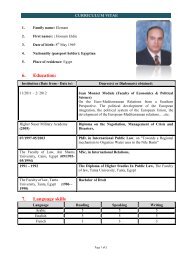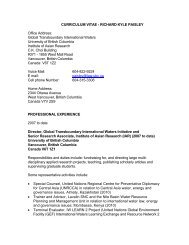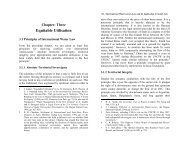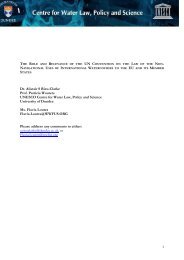Upreti, Trilochan, International Watercourses Law and Its Application ...
Upreti, Trilochan, International Watercourses Law and Its Application ...
Upreti, Trilochan, International Watercourses Law and Its Application ...
Create successful ePaper yourself
Turn your PDF publications into a flip-book with our unique Google optimized e-Paper software.
Equitable Utilisation / 171 172 / <strong>International</strong> <strong>Watercourses</strong> <strong>Law</strong> <strong>and</strong> <strong>Its</strong> <strong>Application</strong> in South Asia(WCD). 222 For example, the Aswan dam in Nile <strong>and</strong> Farakka inIndia have inflicted damage to the environment. Jackson hasrightly observed that the notion of Third World leaders inrelation to environmental protection <strong>and</strong> its relation withdevelopment is that environmental problems can only betackled when poor countries have achieved a certain level ofprosperity. Moreover he gave an example that the first IndianPrime Minister, Mr Nehru, described dams as the temples ofmodern India <strong>and</strong> saw them as a symbol of national pride. 223More than 57% of all dams are in India <strong>and</strong> China. 2243.13 The Role of Joint Commissions in IWCThe idea of treating an IWC as a single unit, ignoring thepolitical boundaries, requires mechanisms that bridge the gapbetween sovereign nations. To pursue this notion, the creationof an agency which is independent of governments <strong>and</strong> able toresolve issues of common concern is essential. The earlywritings of jurists that contributed to the development of thisconcept have been immensely beneficial. For example, Smithenunciated the idea in the 1930s, <strong>and</strong> was supported by222 WCD, Dams <strong>and</strong> Development: A Framework for Decision Making,Earthscan, London, (2000), pp. 8-10. 40 to 80 million people weredisplaced by these dams, people’s health <strong>and</strong> livelihood have oftenbeen put at risk <strong>and</strong> adequate compensation has not been granted. Thishas also caused severe damage to the environment. In two years, thecommission undertook studies of 11 large dams in five continents,surveyed 150 dams in 56 countries, conducted 17 thematic reviewsalong five dimensions of the debate, as well as four regionalconsultations <strong>and</strong> attracted 947 submissions form 97 countries. Alsosee W. Barnaby, “Re-routing World Waterways”, in The Times,December 1 (2000), p. 26.223 B. Jackson, Poverty <strong>and</strong> the Planet: A Question of Survival, London:Penguin, 1994, p. 10.224 Supra note 222, pp. 40-42; also see A. Roy, “The People vs the God ofBig Dams”, The Times of India, 25 October (2000), p. 15.Andrassy, Laurterpacht <strong>and</strong> others. 225 The ILI in its 1911Resolution recommended the establishment of a JointCommission as an advisory body to carry out projects on suchbasins. 226 This idea was also advocated at the Seventh<strong>International</strong> Conference of American States held atMontevideo in 1933. An early Joint Commission to undertakesuch a special responsibility (to determine the best sites forbuilding locks on the Meuse) was constituted in 1785 betweenGermany <strong>and</strong> the Netherl<strong>and</strong>s. 227 Since then, water conflicts<strong>and</strong> disputes have been mitigated <strong>and</strong> resolved through thecreation of bi-national bodies that have greatly contributed tothe equitable resolution of water disputes. The roles of suchcommissions, committees or groups have always remainedcatalytic <strong>and</strong> commendable. 228The reasons for the success of joint bodies are multidimensional.They include neutrality, expert knowledge on thesubject <strong>and</strong> a strong will to seek out a sound <strong>and</strong> acceptableresolution under special circumstances. The tremendoussuccess of such commissions can be seen in practice in themajor river basins. 229 More than 300 IWCs have come intobeing after the rupture of the former Soviet Union <strong>and</strong>Yugoslavia; the numbers are increasing. For most of thewatercourses concerned such commissions are already in place.It is therefore argued that the establishment of a commissioncould contribute to the resolution of any impasse, however long<strong>and</strong> complicated a dispute may be. The constitution of such a225 L. A. Teclaff, The River Basin in History <strong>and</strong> <strong>Law</strong>, the Hague:Martinus Nijhoff, 1967, p. 152.226 Supra note 198, p. 275: Article 7 suggests appointing a JointCommission.227 Supra note 225.228 Even complex issues have been resolved by such entities, for example,by the commissions between Canada <strong>and</strong> the USA, Mexico <strong>and</strong> USA<strong>and</strong> even between arch rivals India <strong>and</strong> Pakistan.229 T. <strong>Upreti</strong>, "The Role of Joint Commission in <strong>International</strong><strong>Watercourses</strong> Issues" The Kathm<strong>and</strong>u Post, 22 July (2001).












